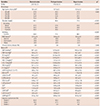1. Lawes CM, Vander Hoorn S, Rodgers A. International Society of Hypertension. Global burden of blood-pressure-related disease, 2001. Lancet. 2008; 371:1513–1518.
2. Julius S, Nesbitt SD, Egan BM, et al. Feasibility of treating prehypertension with an angiotensin-receptor blocker. N Engl J Med. 2006; 354:1685–1697.
3. Mainous AG 3rd, Everett CJ, Liszka H, King DE, Egan BM. Prehypertension and mortality in a nationally representative cohort. Am J Cardiol. 2004; 94:1496–1500.
4. Schulz R, Güther B, Mutert S, Kuhn J. Obesity in Bavarian adolescents: prevalence in trend, sociodemographic structural features and subjective health. Gesundheitswesen. 2010; 72:88–98.
5. Lang RM, Bierig M, Devereux RB, et al. Recommendations for chamber quantification: a report from the American Society of Echocardiography's Guidelines and Standards Committee and the Chamber Quantification Writing Group, developed in conjunction with the European Association of Echocardiography, a branch of the European Society of Cardiology. J Am Soc Echocardiogr. 2005; 18:1440–1463.
6. Nagueh SF, Appleton CP, Gillebert TC, et al. Recommendations for the evaluation of left ventricular diastolic function by echocardiography. Eur J Echocardiogr. 2009; 10:165–193.
7. Chobanian AV, Bakris GL, Black HR, et al. The seventh report of the Joint National Committee on prevention, detection, evaluation, and treatment of high blood pressure: the JNC 7 report. JAMA. 2003; 289:2560–2572.
8. Jang SY, Ju EY, Choi S, et al. Prehypertension and obesity in middle-aged Korean men and women: the third Korea national health and nutrition examination survey (KNHANES III) study. J Public Health (Oxf). 2012; 34:562–569.
9. Weisell RC. Body mass index as an indicator of obesity. Asia Pac J Clin Nutr. 2002; 11:Suppl 8. S681–S684.
10. Ahn HS, Kim SJ, Kim MK, et al. The difference of left ventricular hypertrophy and the diastolic function between prehypertensive and normotensive. Korean Circ J. 2006; 36:437–442.
11. Erdogan D, Caliskan M, Yildirim I, et al. Effects of normal blood pressure, prehypertension and hypertension on left ventricular diastolic function and aortic elastic properties. Blood Press. 2007; 16:114–121.
12. Almuntaser I, Mahmud A, Brown A, et al. Blood pressure control determines improvement in diastolic dysfunction in early hypertension. Am J Hypertens. 2009; 22:1227–1231.
13. Celentano A, Crivaro M, Perticone F, et al. Anti-hypertensive effect of manidipine: 24 hours monitoring evaluation and Doppler-echocardiographic remarks. Blood Press Suppl. 1996; 5:29–35.
14. Brilla CG, Funck RC, Rupp H. Lisinopril-mediated regression of myocardial fibrosis in patients with hypertensive heart disease. Circulation. 2000; 102:1388–1393.
15. Erdogan D, Caliskan M, Gullu H, et al. Aortic elastic properties and left ventricular diastolic function in white-coat hypertensive individuals. Blood Press Monit. 2006; 11:191–198.
16. Bhatia RS, Tu JV, Lee DS, et al. Outcome of heart failure with preserved ejection fraction in a population-based study. N Engl J Med. 2006; 355:260–269.
17. Almuntaser I, Brown A, Murphy R, et al. Comparison of echocardiographic measures of left ventricular diastolic function in early hypertension. Am J Cardiol. 2007; 100:1771–1775.
18. Li X, Cao RX, Lv RR, Cao WH. Study on the trend of obesity prevalence among primary and middle school students in Beijing, from 1985 to 2005. Zhonghua Liu Xing Bing Xue Za Zhi. 2008; 29:469–472.
19. Regenauer A. Does the obesity "epidemic" stop the life expectancy trend? Versicherungsmedizin. 2008; 60:32–33.
20. Eisenmann JC. Insight into the causes of the recent secular trend in pediatric obesity: common sense does not always prevail for complex, multi-factorial phenotypes. Prev Med. 2006; 42:329–335.
21. Zabalgoitia M, Ur Rahman SN, Haley WE, et al. Role of left ventricular hypertrophy in diastolic dysfunction in aged hypertensive patients. J Hypertens. 1997; 15:1175–1179.
22. Miller TR, Grossman SJ, Schectman KB, Biello DR, Ludbrook PA, Ehsani AA. Left ventricular diastolic filling and its association with age. Am J Cardiol. 1986; 58:531–535.
23. Russo C, Jin Z, Palmieri V, et al. Arterial stiffness and wave reflection: sex differences and relationship with left ventricular diastolic function. Hypertension. 2012; 60:362–368.
24. Jang SY, Ju EY, Huh EH, Kim JH, Kim DK. Determinants of brachial-ankle pulse wave velocity and carotid-femoral pulse wave velocity in healthy Koreans. J Korean Med Sci. 2014; 29:798–804.
25. Fenk S, Fischer M, Strack C, et al. Successful weight reduction improves left ventricular diastolic function and physical performance in severe obesity. Int Heart J. 2015; 56:196–202.
26. Russo C, Jin Z, Homma S, et al. Effect of obesity and overweight on left ventricular diastolic function: a community-based study in an elderly cohort. J Am Coll Cardiol. 2011; 57:1368–1374.
27. Vasan RS, Larson MG, Leip EP, Kannel WB, Levy D. Assessment of frequency of progression to hypertension in non-hypertensive participants in the Framingham Heart Study: a cohort study. Lancet. 2001; 358:1682–1686.






 PDF
PDF ePub
ePub Citation
Citation Print
Print


 XML Download
XML Download